Which Sippy cup/straw cup should I buy? A question parents often ask when their baby is ready to start solids, or needs to transition from feeding bottle. You may hear/read terms like a soft spout, hard spout, trainer handles, transition cups, trainer cups, free flow cups, etc. So which cup to buy for your baby? What type of spout is better? When do you start using a sippy cup?
Read more to know different types of cups and what features to look for when buying a cup for your baby. Also, our recommendation for popular sippy cups.
Decoding baby sippy cups
Let us decode the sipper cups by first understanding why sippy cups are popularly used. These cups help a baby transition from breast or bottle feeding to a regular cup/glass. They are usually designed as spill proof, enable mimicking sipping action, ease of holding as per baby’s age. These features help a baby to transition to drink from a regular cup while building the confidence of drinking by self and practising the natural sucking action.
Should I buy a sippy cup
Does a baby really need a sippy cup? That depends! Most of us grew up without sippy cups. We were either bottle fed, or had liquids from a spoon and a bowl and transitioned to the regular (baby size) glasses. Drinking from a glass requires some training and parental guidance. And it also involves a lot of spilling.
These days, especially with working parents, hectic lifestyle, limited help for childcare, etc. parents may not have enough time or resources to take care of all the spilling/cleaning when a child transitions to a regular cup. Hence a sippy cup makes a great choice.
Remember, age-appropriate sippy cups, are to help a child to transition to drinking from a regular glass. And to provide a spill-free cup when outdoors or travelling. Do not over-rely on them.
Which sippy cup should I buy
Sippy cup, straw cup, transition cup, trainer cups …. these names are popularly used by different manufacturers. Some of the names are interchangeably used. It is best to look for essential features when buying a cup:
- Type of spout
- Material
- Ease of use
- Ease of cleaning
- Sturdy design
- Age suitability
Do remember that as the baby grows older, the features that suit your baby’s needs changes.
Sippy cup features to look for
1. Type of spout
A sippy cup comes in following different spouts:
- Soft Spout
- Hard Spout
- Straw
- Open rim or spoutless
2. Material
A sippy cup may be made of plastic, steel, or even glass. The spout may be made of silicone or plastic.
When the baby is less than 9 months old, usually a lightweight cup would be better. So opt for a plastic one or a lightweight steel one. Usually, food grade steel is better than plastic. Opt for medical grade silicone spout over plastic.
3. Ease of use
Grip: The cups are designed for babies tiny hands to hold them properly. For a baby under 9 months of age, trainer handles are useful to help a child hold the cup and invert it for sipping. For a baby older than 9-12 months, the shape/grip of the cup should be such that a baby can easily hold it in both hands.
Cover: A cover is highly recommended as babies are invariably prone to dropping/throwing the cups. A cover ensures the spout remains clean and reduces multiple cleaning after each fall. Opt for a cup with a cover that at least covers the spout/sipping rim completely.
Spill-free & leakproof: Opt for spill-free cups. The valves should hold back the liquid well, yet allow easy sipping. The cups should not leak when inverted or thrown by an excited baby. Very vital feature when the baby is still learning to drink from a cup or when drinking milk/juices.
4. Ease of cleaning
Babies are messy. One should ideally clean a Sippy cup daily (sometimes, depending on the mess even more frequently). So the sippy cup should be easy to clean. The different components viz. inner straw, spout, cover, valve, etc. should be easy to take apart and clean. The design should not have difficult to reach parts, especially the valves and spouts.
5. Sturdy design
Again, sippy cups should sustain frequent falls, especially with younger babies. So the material, as well as design, should sustain falls without breaking or cracks. Ensure the cover, spout lid, have no protruding parts.
6. Age suitability
Your baby can transition from a feeding bottle or breast to a sippy cup anytime after 4-6 months of age. Choose an age-appropriate cup that helps your baby transition to a regular cup/glass.
4-9 months: For a baby in the age group of 4-9 months usually requires a soft spout. SSome babies transition directly to a hard spout.
Babies in this age group are usually comfortable with trainer handles as they may find it difficult to hold the cup.
Many cups come with a free-flow design (or a removable valve to convert a cup to become free flow). It may be useful when the baby starts with sippy cups. They work, as the name suggests, as free-flow when inverted (and usually require sipping when held straight). This is great when transitioning from the bottle to a cup and also till the baby learns to sip from the cup.
Soft or hard spout is not recommended for a long time as they can hamper speech development.
9-12 months: A baby can switch to straw cup around 9-12 months. Some babies may directly go to a straw cup.
12+ months: For a baby older than 12 months one can opt for spoutless or a cup with rim for drinking.
Different types of sippy cups
Watch this video to know more about the different types of cups and features to look for when buying a sippy cup:
Our Top 8 recommended sippy cups
There are so many sippy cups in the market. We pick top 8 ones with the focus on their features and popularity. Also, all the cups we picked up have a sturdy design (minimum to no protruding parts, easily breakable covers, simpler designs) to sustain the frequent falls/throwing which is common with babies.
1. Tommee-Tippee-First-Sips-Soft-Spout-Transition-Cup
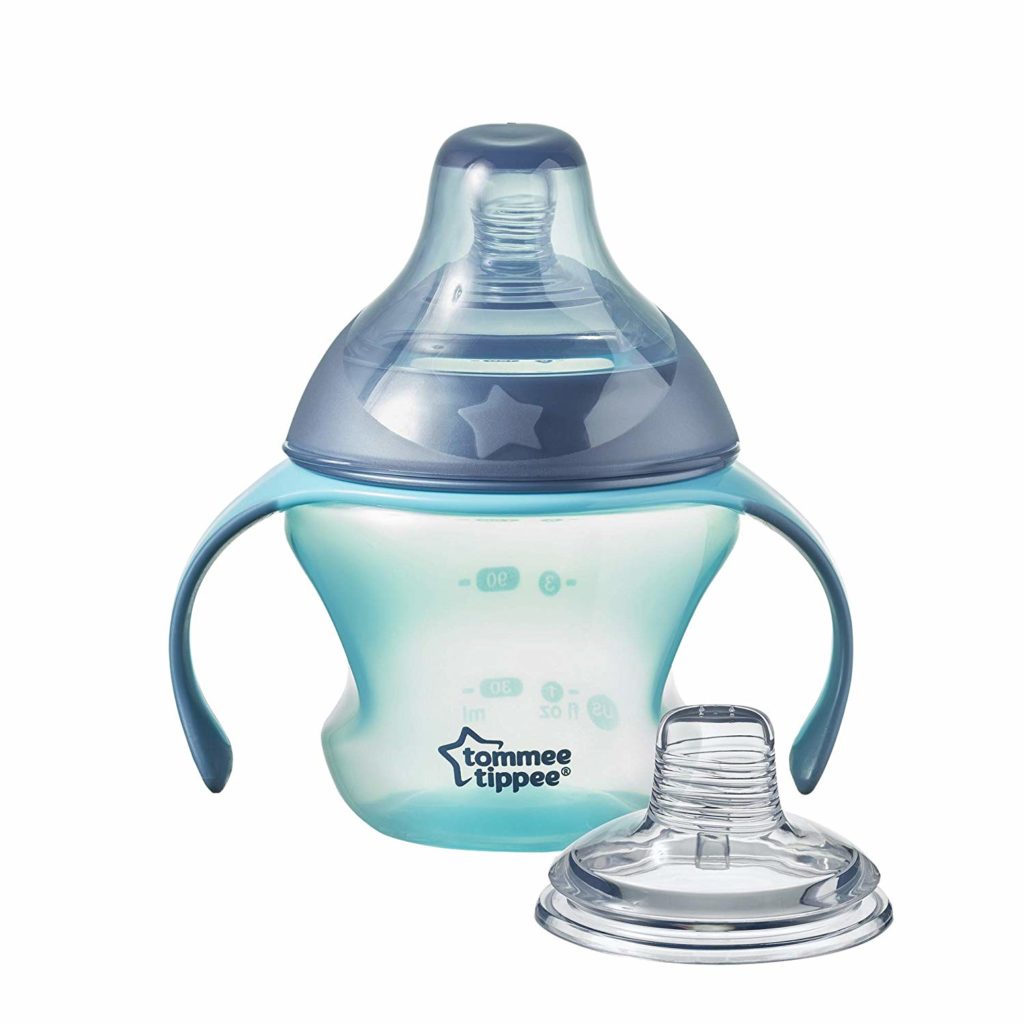
Features:
- Useful from 4 months
- Material: Bottle made from BPA free plastic, nipple/spout from silicone
- Multiple drinking options: ‘Close to nature’ nipple for a breast/bottle feel and a soft spout; similar material avoids bottle/spout confusion
- Ease of cleaning: Easily detachable parts and easy to clean spout, bottle and lids
- Ease of use: Spill-free design (spout with in-built valve), easy grip detachable trainer handles, offset spout designed to promote natural cup drinking action, comes with spout cover
Cons:
- Slightly tricky to assemble the parts for spill-free experience
- Costly
2. Philips Avent Classic Soft Spout Cup
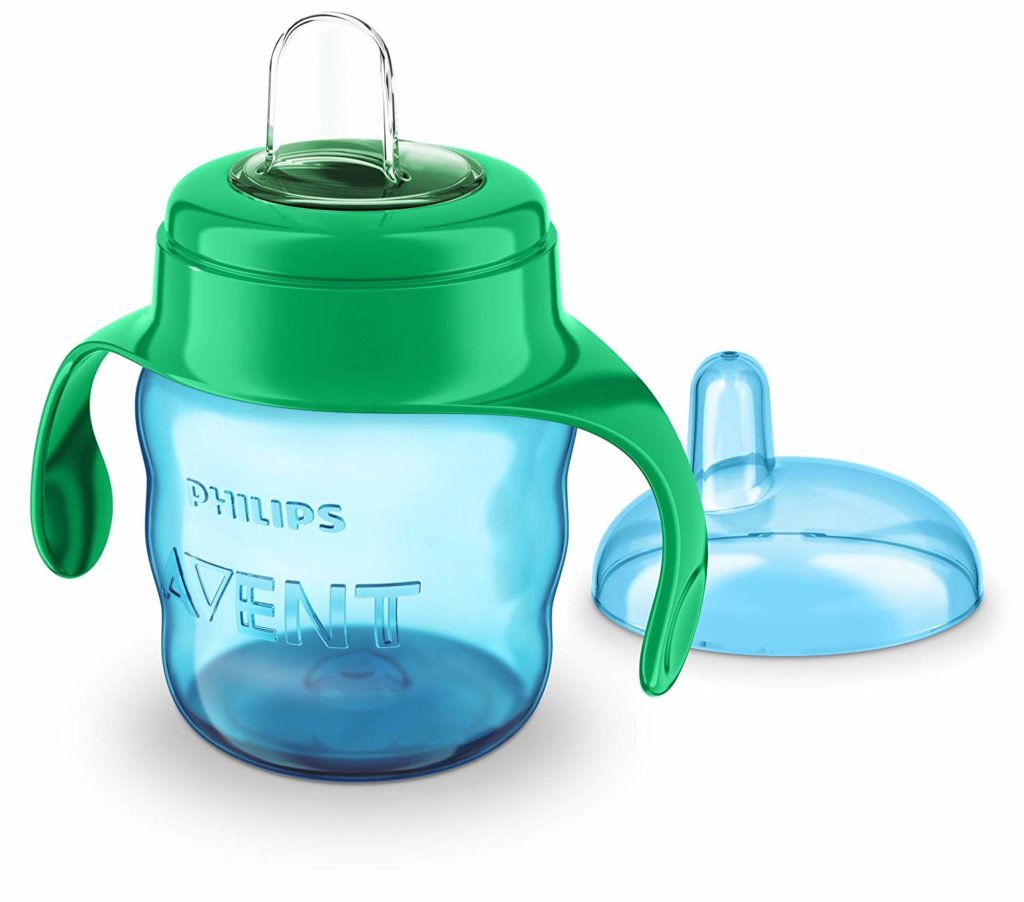
Features:
- Material: Bottle made from BPA free plastic, spout made from silicone
- Ease of use: Spill-free design (spout with in-built valve), trainer handles and bottle designed for easy grip, drink water by putting pressure on spout, comes with spout cover
- Ease of cleaning: Easily detachable lid and easy to clean spout, bottle and lids
- Cost-effective
- Compatible with Philips Avent Natural and Classic bottles
Cons:
- Trainer handles are not detachable
- The spout is thin and hence prone to breaking while cleaning
- Water flow may be more for some babies
3. Babyhug Hard Spout Cup

Features:
- Material: Bottle and spout made from BPA free plastic
- Ease of use: Spill-free & leakproof design, detachable trainer handles & bottle designed for easy grip, comes with spout cover
- Ease of cleaning: Easy to clean spout and bottle
- Cost-effective
Cons:
- Plastic spout
4. Philips Avent Premium Hard Spout Cup
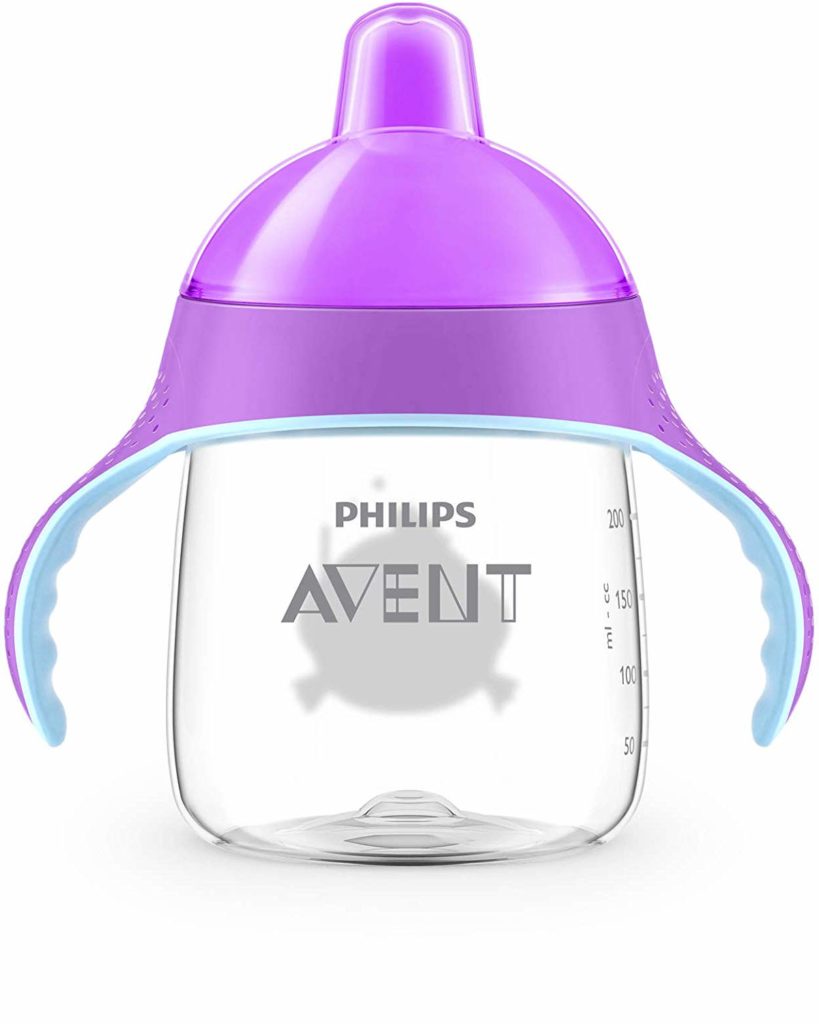
Features:
- Material: Bottle and spout made from BPA free plastic
- Ease of use: Spill-free & leakproof design, trainer handles/bottle designed for easy grip, angled spout for ease of drinking, comes with spout cover
- Ease of cleaning: Easy to clean spout and bottle
- Compatible with Philips Avent Natural and Classic bottles
Cons:
- Trainer handles are not detachable
- Plastic spout
5. Pura Kiki Stainless Steel Straw Cup

Features:
- High-quality material: Plastic-free; bottle made from food grade stainless steel; sipper, straw, sleeve from medical grade Silicone
- Ease of cleaning: Easily detachable parts and easy to clean straw, bottle and lids
- Ease of use: Spill-free & leakproof design, the sleeve gives good grip, flexible non-breakable travel cover, measurement marking visible outside as well as inside
- Grows with child: Easily converts from a feeding bottle to a sippy, a straw or a sports bottle by simply replacing the spout/lid with another required Pura nipple/spout/straw/lid

Cons:
- Costly
- The bottle base is prone to denting
- No trainer handle
6. Fisher Price Straw Bottle
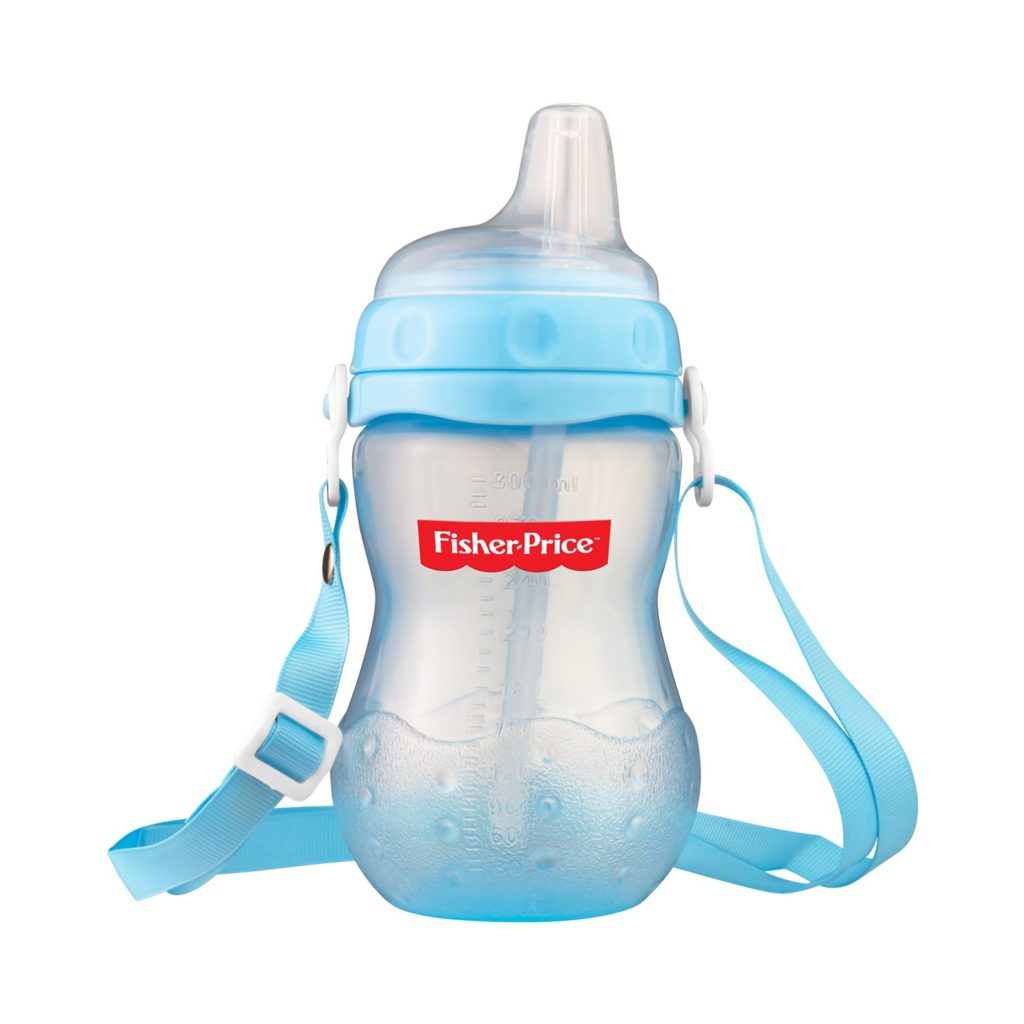
Features:
- Material: Bottle made from BPA free plastic; sipper from silicone
- Ease of cleaning: Easily detachable parts and easy to clean straw, bottle and lids
- Ease of use: Spill-free, leakproof design, adjustable neck string, comes with spout cover
- Cost-effective
Cons:
- Some babies may need to put more pressure for sucking
7. Munchkin Miracle 360 Trainer Cup
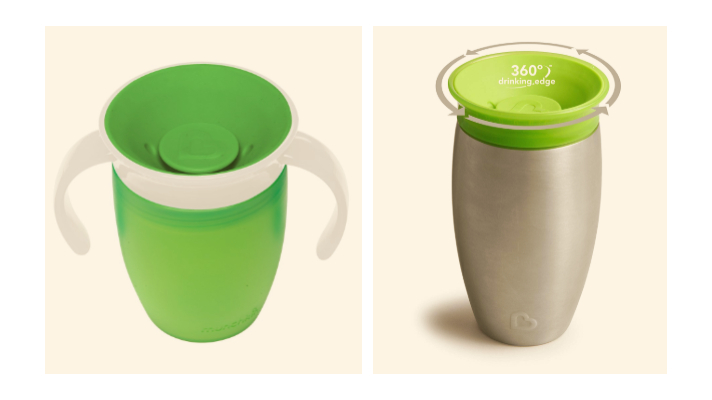
Features:
- Usable from 6+ months
- Spoutless design, easy to transition to regular cups
- Material: Comes in BPA free plastic and steel versions
- Ease of cleaning: 3 easily detachable parts for cleaning
- Ease of use: Spill-free & leakproof design, comes in trainer handler and handleless version
Cons:
- Valve needs careful cleaning when used for milk/juices
- No cover: Drinking rim exposed at all times, not desirable when outdoors
8. Reflo Smart Cup – trainer

Features:
- Usable from 6+ months
- Spoutless design, 360 rim for easy to transition to regular cups
- Material: Comes in BPA free plastic
- Ease of cleaning: Easy to remove insert from the glass for cleaning
- Ease of use: Spill-free & leakproof design, just 2 components (cup & insert), water flows in steady stream, glass easy to hold in tiny hands
Cons:
- Costly
- No cover: Drinking rim exposed at all times, not desirable when outdoors
Conclusion
Buy an age-appropriate sippy cup for your baby that is easy to clean, easy to handle, child safe and helps transition your child to drink for a regular cup. You may need to invest in more than one cup. Give your baby some time to get used to sippy cups.

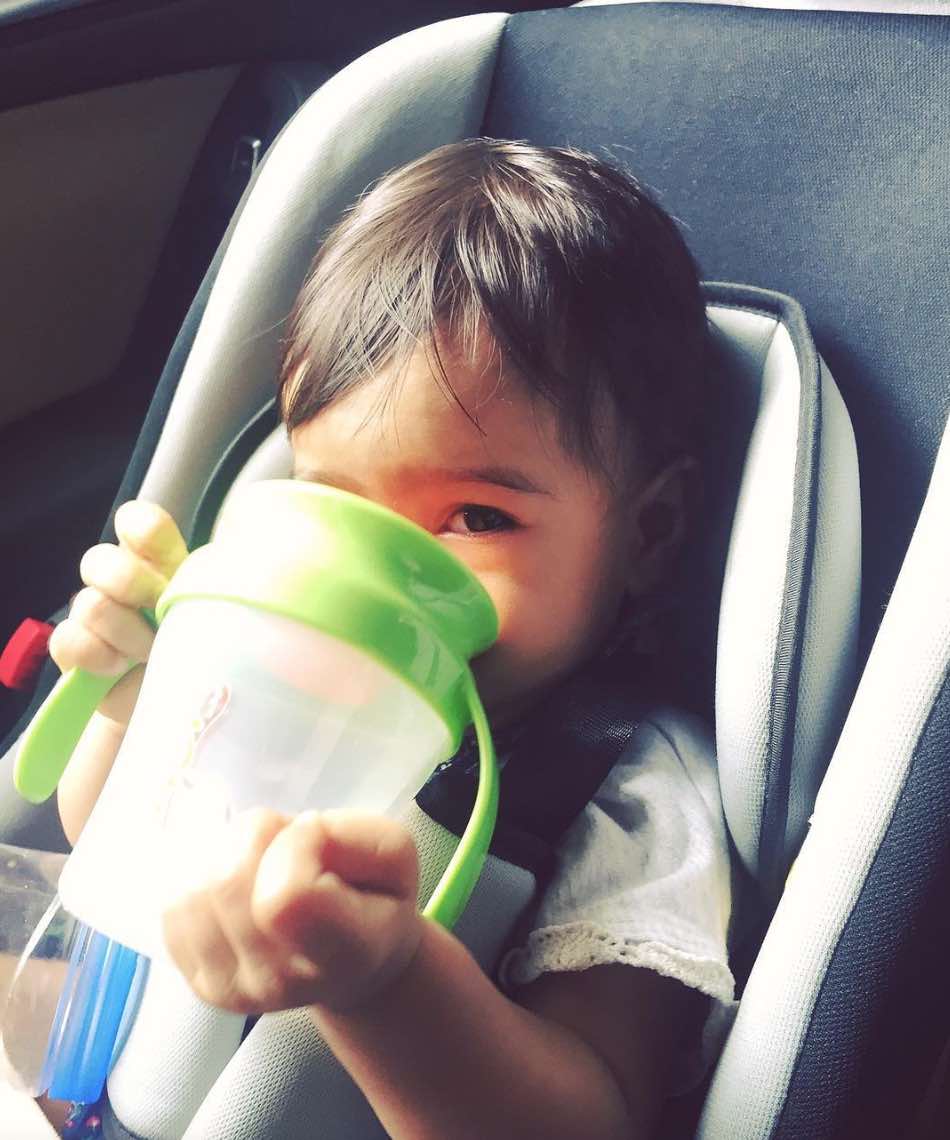



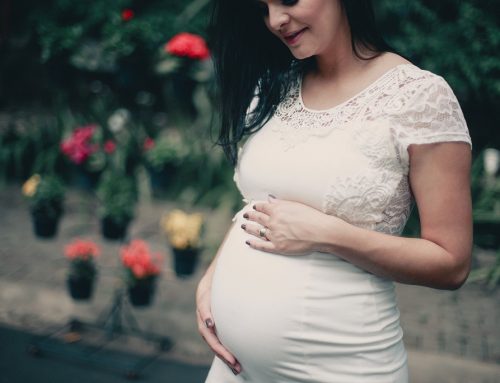
Great post! When should I child completely shift to open cup?
Hi Aishee. As soon as possible. Babies can switch to an open cup even at 6 months of age. If you are using a soft or hard spout cup, then transition to a straw or an open cup before the baby is a year old. If your baby is older than 1 year and using a straw cup, you can try introducing an open cup.
Awesome post. I am going to try straw cup for milk. It’s late now as my son is 2 years. Fingers crossed.